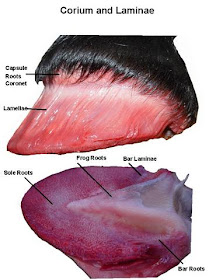The coffin bone is surrounded by a matrix of blood vessels and connective tissue called the corium. The corium produces the external structures of the hoof.
 |
| Corium |
As the picture below shows, there are different zones of the corium that make the different parts of the hoof. The structures that grow from the corium are:
- hoof wall
- sole
- frog
- bars
- laminae
 |
| Photo from ABC Hoofcare |
Since the hoof wall grows out of the coronary band at the top of the hoof, there needs to be something to connect it to the coffin bone all the way down to the ground- that's what the laminae are for. When magnified the laminae looks a bit like feathers, with many little "fingers" that grow along the edges. Because of this, the corium's laminae can grab onto the hoof wall laminae like velcro, locking the hoof wall and the coffin bone tightly together. Unfortunately the laminae tend to break under pressure or otherwise adverse conditions, something I'll write about more later.
If you've picked up a hoof you've seen laminae- at the sole level laminae become the white line.
 |
| hoof wall showing laminae extending towards the corium |
 |
| magnified view of the laminae |
 |
| well-connected growth |
This post marks the end of the information that everyone agrees on. Where I go from here might be a bit... um... controversial. Buckle up!
Bring it on! ;-) The illustrations of the corium and laminae are really helpful in understanding how it's all put together. That hoof in the x-ray is pretty nice. I wonder what breed the horse was or what it's job was.....
ReplyDeleteControversial can be good :) Love all this info, thanks for posting it!
ReplyDeleteI figure there must be lots of opinions because everything I've looked at seems to be all over the place. Good for you having the patience to wade through it.
ReplyDeleteInteresting photos, although the first one made me a little ill... Hey, there's a reason I didn't go to vet school! I'm enjoying these very informative posts, and look forward to the rest of them!
ReplyDeletehttps://i.imgur.com/AbgXWV0.jpg
DeleteThat's cool! Thanks for the photos and information...I had no idea it looked like that. I have my xray of a broken P3 that you're welcome to use if you ever need it in your discussions.
ReplyDeleteWolfie, sadly there was no information on the site I scarfed that x-ray from. Notice it was barefoot though ;)
ReplyDeleteTBA- then lucky you, controversy coming up!
MiKael- it's taken months but I think I've gotten a handle on it. It takes an understanding of the internal structures of the hoof to really get it though. Thus why I started this way.
i2p- I'm going to gross you out by saying I can't wait to get my hands on a cadaver hoof, so much more to learn and see! Seriously though, it is kind of gross.
Linda- I haven't studied fractures yet so I don't have anything useful to say about them. I could do some research for you though.
Very helpful pictures. Dusty has a minimal rotation of her coffin bone but working with the vet and our excellent farrier, they actually think it may return to normal with time. The rotation is so slight it doesn't bother her at all. These pictures do help to understand better the medical jargon.
ReplyDeleteI'm so glad for Dusty, rotations really can return to normal if you take care of them right.
ReplyDeleteGreat explanation and photos!! I really like the way you put it all together like you did. I think so many people know the parts of the hoof, but fail to realize how they are all connected.
ReplyDelete